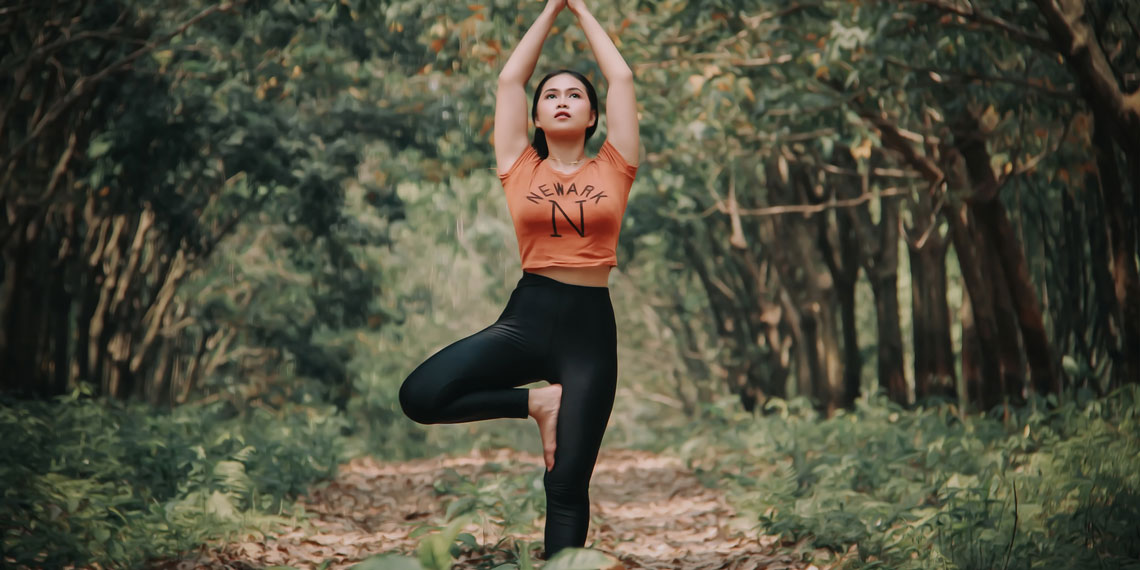If you’re like me, going to the gym is as rare as a monogamous Kardashian couple: it just doesn’t happen. The main reason I don’t go to the gym, though (aside from being a lazy piece of sh*t), is that I’m terribly embarrassed by my lack of athletic ability. Three minutes on a treadmill and I’m heaving over the garbage can. And don’t even try me with weights. I’d be lucky to get five pounds off the ground. And SoulCycle? I nearly crapped my pants doing that. Never again. But, admittedly, I do need some form of physical movement in my life. It’s pretty upsetting that I can’t go up a flight of stairs without feeling faint. I am told that’s like, bad for you?
Basically, I need a workout that won’t make me super short of breath, which led me to yoga. I mean sure, yoga can be hard (especially if you’re sweating all your water weight out in a 94-degree studio), but it doesn’t kill me the same way that a Barry’s Bootcamp class would. Which made me wonder: is it too good to be true? Can I do yoga every day and still get the summer body I’ve been putting off working on since…summer 2014? I spoke to personal trainer and owner of Frame Fitness in Toronto, Melissa Bentivoglio, about whether or not we can trust yoga as a main form of exercise.
I need a trainer who will understand that I want to be fit without breaking a sweat or being uncomfortable in literally any way
— Betches (@betchesluvthis) September 3, 2019
Is Yoga A Real Workout?
Yes, but it’s not as simple as that. The point of Yoga is to focus your energy on specific tasks, poses, and flows. According to Bentivoglio, different types of Yoga work your body in specific ways. “The forms of Yoga can vary from physically demanding and vigorous Power Yoga to meditative and Restorative Yoga.”
For example, in a Vinyasa class, if it is instructed in a rhythmic, continuous, and intense fashion, Bentivoglio notes, “it can certainly elevate the heart rate to be considered a form of aerobic exercise.” In slower-paced Yoga classes, though, Bentivoglio says, “there could be more focus on holding isometric poses, which focus more on strength building.” These are examples of less traditional cardio workout circuits, but nonetheless, still a form of exercise.
How Can You Make The Most Of Yoga As A Workout?
So apparently lying in child’s pose and napping meditating for an hour doesn’t really make the most of utilizing Yoga as a workout. Who would’ve thought? Bentivoglio suggests taking classes based on what you would like to focus on. There is no right or wrong when it comes to choosing. All components of yoga can benefit your health. “Strength training is a key component of health and fitness. Building lean muscle mass helps burn more calories at rest, even if you are not perspiring profusely. Cardio is also an important form of exercise as it improves cardiovascular health,” says Bentivoglio.
Even if you’re not profusely sweating, you’re still getting a lot out of your time. If you want to take a cardio-centric route, that will help benefit your heart health. Pick the type of class that focuses on a part of your body or health that you really want to improve on. Yoga isn’t a fix-all sort of exercise (does that even exist?) and it takes time to work out each part of your body through a variety of flows and methods.
What Is The Most Common Myth About Yoga?
“The most common myth is that you have to be flexible to do it,” says Bentivoglio. If you’re like me and can’t touch your toes, this is a huge relief. “Some forms of Yoga require a greater amount of stamina and power than they do flexibility. But the benefit overall of Yoga is that the more you keep at it, the more flexible you’ll feel yourself become,” she adds.
It won’t happen all at once, so don’t try to do the splits when you’re six shots deep and really want to show off—you’ll just end up with ripped pants and a torn ACL. Patience is key, which is f*cking annoying, because who likes to wait for anything nowadays, but I guess that’s better than the StairMaster, so I’ll take it.
How Can Beginners Get Started?
First, you need to identify what you want to achieve. Pick an end goal, and then find the types of Yoga that help you best work towards that. It doesn’t need to be the same thing every week, but finding a routine and pattern will reap the benefits much quicker. Bentivoglio explains, “if one would like to start doing Yoga to alleviate stress and anxiety, meditative Yoga could help by calming the mind by combining poses with breathing and mantras.”
Meditative combines breathing with calming poses and mantras. If flexibility and strength are your goals, hot Yoga could be a good place to start. If you’re looking to just start with the basics and then find your footing, Hatha Yoga is the way to go. Overall, beginners should start off slow then build their way up to more high-intensity classes like Vinyasa.
What Are Some Apps For Practicing Yoga?
If you’re like me and still having some anxiety about actually being in a room with other people, apps are super useful. Here are some of Melissa’s favorites for different types of flows:
Pocket Yoga: Good for beginners who want to practice yoga and learn new poses. There are also pre-set flows that you can try out.
Universal Breathing: A fantastic app that helps you focuses on breathing. It’s a great way to alleviate stress, headaches, and lower blood pressure, among other things.
Asana Rebel: Provides Yoga workouts that incorporate both strength training and cardio-based poses and flows. Their sessions can last about 30 minutes and are structured in a very effective and fun way.
So it seems like, yes, Yoga can be a legit workout, provided you are realistic about what you want out of a class and you choose the right class based on your fitness goals.
Images: Yayan Sopian / Unsplash; showerthoughts / me.me; betchesluvthis / Twitter



















































